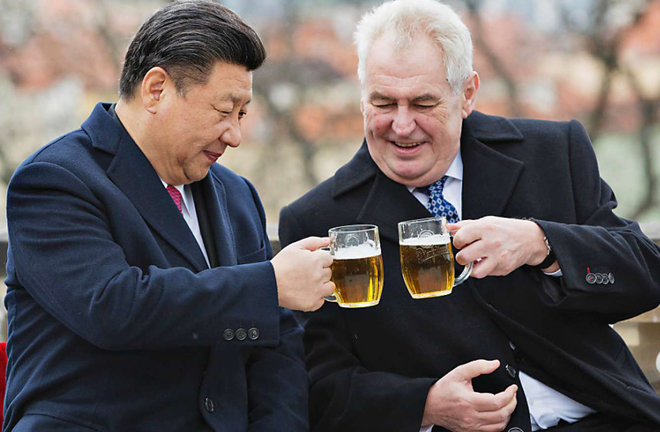Scholars: President’s Czech visit continues trend of warming ties

Chinese President Xi Jinping (left) and his Czech counterpart Milos Zeman clink glasses of beer during his visit to the Czech Republic from March 28 to 30.
Chinese President Xi Jinping paid a historic visit to the Czech Republic from March 28 to 30 to elevate bilateral ties to the level of a strategic partnership. Scholars said the warming of relations with the Czech Republic, sometimes called the “Heart of Europe,” has set a new model for diplomacy with Central and Eastern European countries, laying the foundation for further cooperation in the region.
Located in the center of Europe, the Czech Republic is not only a member of the European Union and NATO but also an important part of the “16+1 cooperation” mechanism. This year, it has assumed the rotating presidency of the Visegrád Group, a significant sub-regional organization in Central and Eastern Europe.
Huo Yuzhen, former Chinese ambassador to the Czech Republic and special representative for Central and Eastern European cooperation at the Ministry of Foreign Affairs, pointed out the advantageous location of the Czech Republic, which acts as a hub for all of Europe.
The Czech Republic also has a solid industrial base that makes it one of the most economically developed countries in the region. The Czech Republic has become more pragmatic in its dealings with China in the past two years, which has contributed to the fast growth of bilateral trade, said Kong Tianping, a research fellow from the Institute of European Studies at the Chinese Academy of Social Sciences.
The Czech Republic is the second-largest trade partner of China in Central and Eastern Europe after Poland. In 2015, direct flights were opened between Beijing and Prague, and the number of Chinese tourists to the Czech Republic grew by 35 percent compared to the previous year to reach 285,000.
Huo, who worked in the Czech Republic for many years, also used “rapid” to describe the development of economic and trade cooperation between China and the Czech Republic. In the past 10 years, the Czech Republic’s exports to China have nearly tripled.
During Xi’s visit, the two sides signed agreements covering a number of fields. Huo regarded the president’s tour as a milestone, saying it reflects the robust momentum of bilateral relations. The establishment of a strategic partnership marks a new era, Huo said.
Huo added that the Czech Republic will be a good role model for the “16+1 cooperation” mechanism, and particularly, take the lead in regional cooperation.
The Czech Republic has played an active role in the mechanism since it was established, Huo said. So far the country has hosted the regional “16+1 cooperation” leaders meeting and health ministers meeting.
President Xi’s visit will further inspire Central and Eastern European countries to cooperate with China in such areas as trade, investments, infrastructure construction, energy, science, technology and culture, Huo said.
Xi’s trip also coincided with the first anniversary of the launch of the “Belt and Road” initiative, which was proposed on March 28, 2015. Scholars said that the “Belt and Road” initiative can be taken as an opportunity to promote Silk Road diplomacy, thus propelling China to extend bilateral, sub-regional and regional cooperation in Central and Eastern Europe.
With the establishment of the China-Czech strategic partnership, the two sides are expected to sign an additional memorandum of understanding containing a more detailed outline for cooperation. They will finish the outline as soon as possible to prepare for major programs involved.
Zhang Junrong is a reporter at the Chinese Social Sciences Today.
